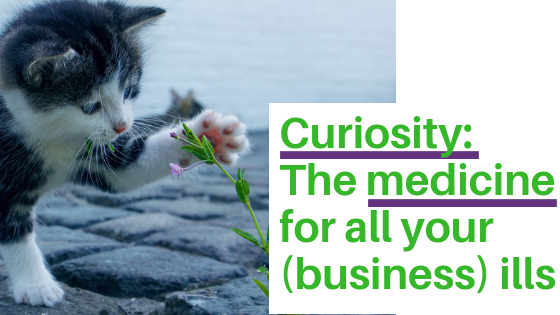Where would the human race be without curiosity? Most likely, we would still be huddled together in dark, fireless caves, getting awfully tired of the taste of raw meat, and going everywhere on foot. There would have been no fire, no wheel, no advancement of any kind. Without curiosity, humanity would scarcely be able to survive, let alone thrive!
Curiosity is the spark of new knowledge that drives us forward in all aspects of life: In in business, or at home with our treasured families. Each new day dawns with infinite possibilities of how to be better at the million-and-one things we all do.
At the heart of each and every one of those possibilities is curiosity. It is our sense of wonder at how, what, when, where, and why anything can and will happen.
Is there a business case for curiosity?
Curiosity enriches our lives in an emotional sense, and in a philosophical sense. But studies also show that it makes us more creative.
Creativity that adds value to a business is called innovation. Innovation is what enables our companies to adapt, flex, and grow.
In a study conducted by the INSEAD’s Spencer Harrison, artisans who sold their wares through an e-commerce website went through an evaluation that aimed to assess their curiosity. Then over two weeks, their creativity was then measured as the number of items they listed for sale on the site. What the study found was that for every single-point increase in curiosity – for example, from 3 to 4 – the artists’ level of creativity could increase by as much as 34%.
If you think that this kind of impact wouldn’t apply in a more conventional role – such as a call centre – think again. The same researchers found that higher levels of curiosity result in behaviours that better enable employees to do their jobs. Such behaviours include information-seeking.
In terms of productivity and efficiency, curiosity is an important trait.
Despite the benefits of curiosity, employers don’t encourage it
There is a direct link between curiosity, creativity, and productivity. Great news!
Well, not quite. According to Francesca Gino at Harvard Business Review, curiosity isn’t actively bred or encouraged in the workplace.
Gino asked 3,000 employees in a variety of industries about their sense of curiosity. According to her findings, just 24% said they felt curious in their work on a regular basis. Seventy per cent (70%) said they faced barriers when asking questions at work.
What is worrying is that 92 per cent of those studied said that curious people bring new ideas to their organizations. They told Gino that curiosity is a catalyst for everything: From job satisfaction to higher levels of performance.
So, what is stopping leaders from taking advantage of curiosity? As a tool, it seems that it could build happier, more creative, and more productive teams more effectively.
Well, Gino had an answer for that, too. After speaking to 520 Chief Learning Officers and Chief Talent Development Officers, she learned that the reason is two-fold. They are:
- A belief that their companies would be more difficult to manage if they allowed workers the time to explore their own interests.
- A belief that allowing workers time to be curious would lead to more internal disputes, slow down the decision-making process, and thus increase the cost of doing business.
What does this mean? It means that employers prize efficiency over their company’s ability to innovate.
But it doesn’t have to be this way.
How to break your curiosity barriers
There are many ways in which you can encourage curiosity in your workplace. Some shining examples lead the way.
One is to help workers broaden their horizons. In her book Rebel Talent, Francesca Gino gives us the example of Osteria Francescana, one of the world’s top restaurants. There, head chef and owner Massimo Bottura has his staff members cook a dish from their own culture once a week for the rest of the kitchen crew to try. In this way, the team learns about the cultures in the team, and everyone learns new ways of cooking with the same ingredients they use every day.
Another example comes from Google. There, staff are asked to spend 20 percent of their time on a ‘what if’ question of their own choosing. As such, they get to spend a good portion of their schedule actively pursuing innovation and creative ideas, exploring avenues that workers in other organizations don’t have the energy or time to pursue.
You can simply encourage people to ask ‘why’ and ‘what if’ questions about things in your workplace that are always the same.
But if that is a bit of a stretch straight away, don’t panic: There are some other ways in which you can encourage curiosity in your workplace.
Hire curious people
One way to get ahead of the game is to hire people who already know how to think outside the box.
How do you find workers who are naturally curious? Well, it it starts in the job interview. Ask potential hires about their interests outside working hours.
- Do your potential hires read books unrelated to their fields?
- Do they actively explore things they don’t know about, just for the sake of knowledge itself?
Watch for curious behaviours.
- Does your potential employee ask questions him- or herself in the interview?
- Are they standard questions or unusual questions?
All of these are indications of perpetually curious mind. Curious minds are like a goldmine because they will elevate not only the worker, but they will consistently work to build up the business and the people around them as well.
Encourage your employees to pay meaningful attention
Curiosity goes hand-in-hand with mindfulness. You can’t effectively use one without the other. Check out this quote, plucked from the pages of a study on Alzheimer’s Disease, and presented in this report at mindful.org.:
“Attention is important to the understanding of curiosity because it directly correlates with one’s abilities to selectively focus and concentrate on particular stimuli in the surrounding (and I would add internal) environment.”
As author of the report, Patricia Rockman points out, Attention could easily be swapped out for mindfulness. By paying attention, you are able to be curious about your experiences: Your external ones and your internal ones.
In other words, being mindful frees you to be curious about your life, and your work.
Use The ORANGES Toolkit to give your employees the tools to access both mindfulness and curiosity
One of the most effective ways of building mindfulness and curiosity is the ORANGES Toolkit.
In one of our previous articles, Jenni Allan, CEO of ADSSI HomeLiving Australia explained how how ORANGES has helped her team to make mindfulness a regular part of their daily routine.
‘We’ve started doing mindfulness regularly at most team meetings,‘ Jenni explained about some additions they have made to their regular agenda. ‘We’ll have a few minutes using an app just to focus our minds on where we are.‘
This focus will help you to build a communal sense of curiosity, creativity, and productivity in your workplace too. In so doing, you will see your workers, your business, and you yourself!, really start to thrive in all areas of life.




Leave A Comment